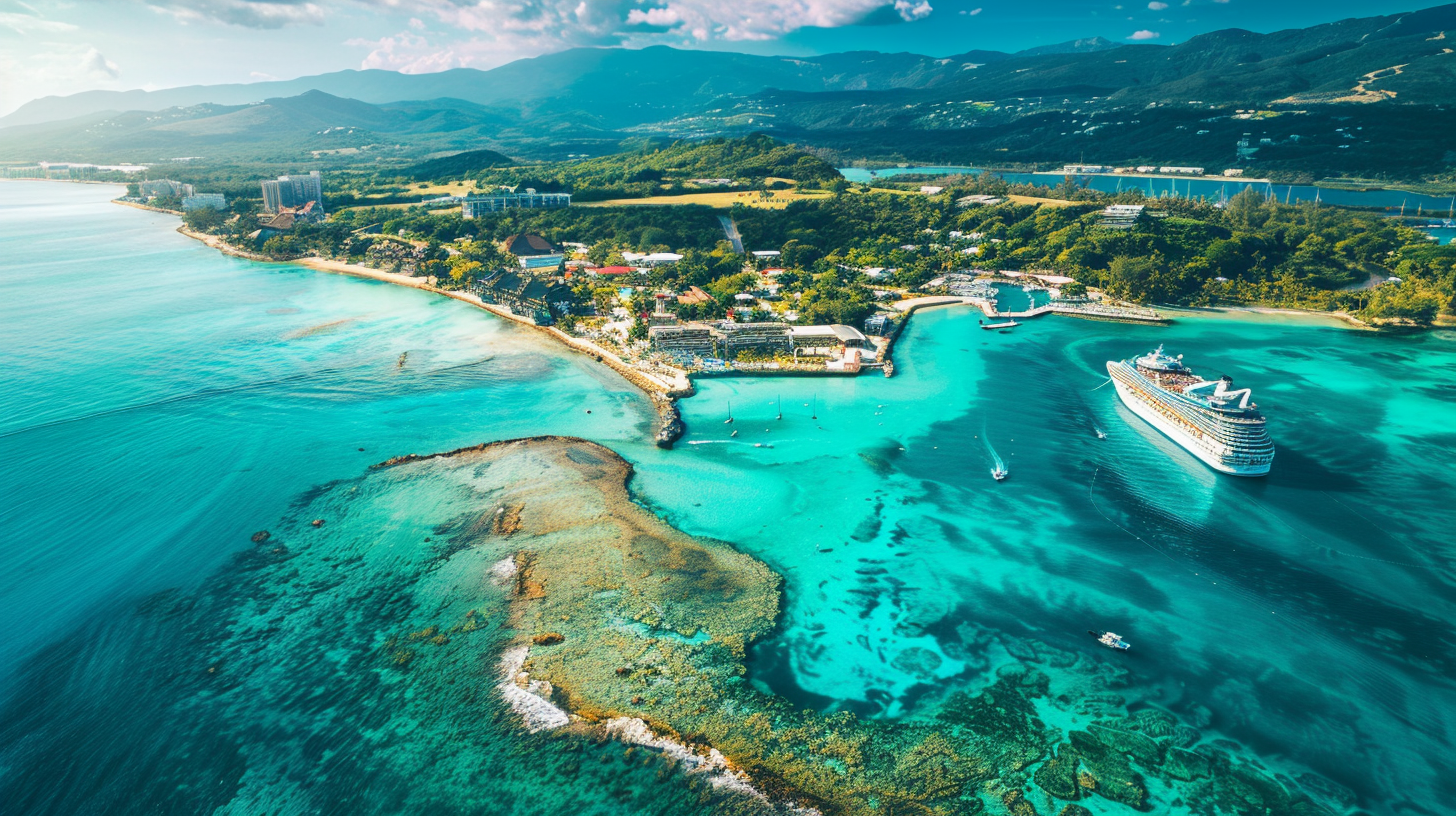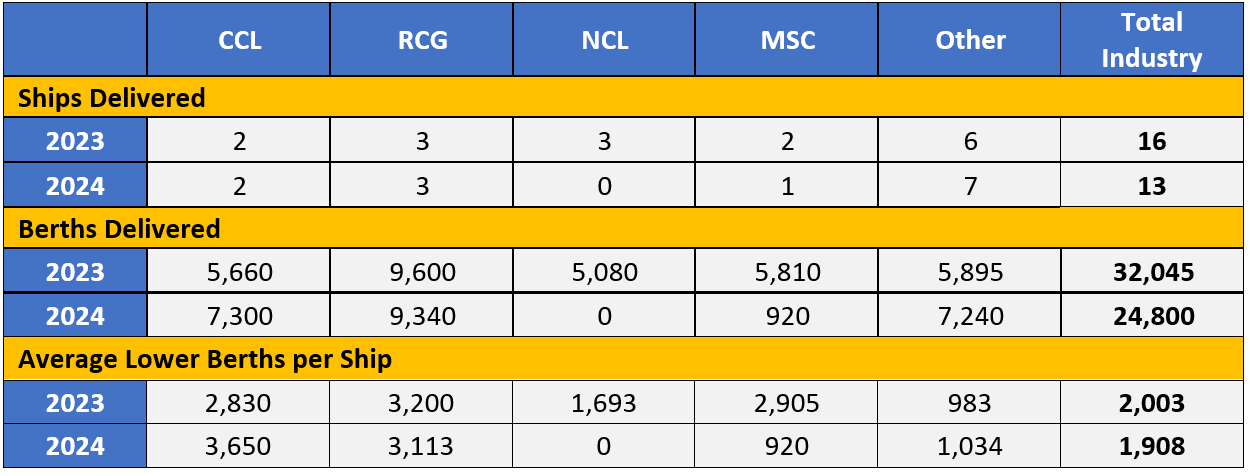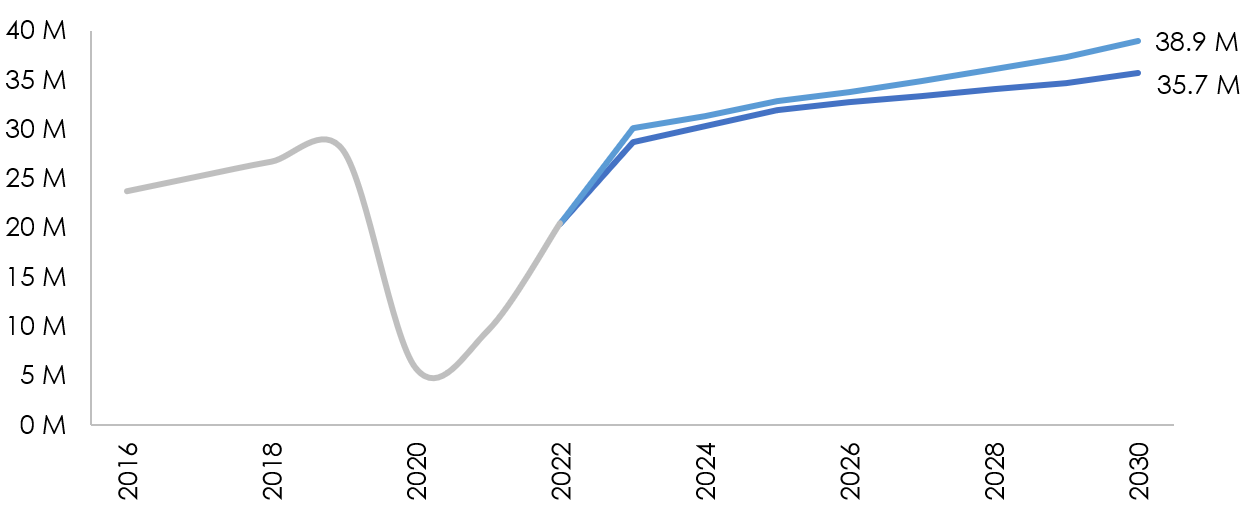Nassau Cruise Port Global
BA’s design for the waterfront features a completely transformed Port and Welcome Center, additional mega berths to accommodate the largest cruise ships in the world...
Gain deeper insights into the maritime industry with detailed updates on key developments and trends, meticulously curated by our team of specialists.

With the cruise industry having successfully rebounded from the pandemic in 2023 – characterized by surpassing 2019 levels in several key metrics: expanded its capacity with more lower berths available, achieved higher occupancy rates and ticket prices, and welcomed a greater number of passengers in 2023 compared to 2019 – it is all but given that the industry will continue to thrive in 2024, and beyond. In this bulletin, BA touches on what to expect from 2024, providing industry forecasts through 2030.
From 2023 to 2024, the cruise industry continued to grow. 2023 witnessed the delivery of 16 ships from major cruise brands, contributing an additional 32k lower berths towards overall capacity expansion.
Heading into 2024, the current order book stands at 53 ships and 107k lower berths. The orderbook currently has ships on order through 2028. Coming out of the pandemic, as operators look to decrease debt, there has been a lull in operators placing new ship orders. It should be noted, however, that the temporary lull should not be misconstrued as a long-term decline. There is a prevailing sentiment that more orders will be placed for subsequent years, specifically for 2026 and beyond.
13 of these ships, and 25 k lower berths, from 12 cruise brands, are set to debut in 2024. That equates to adding over 1.1 million new passengers annually (not including any withdrawals). As the newly added capacity becomes operational in 2024, it is anticipated that the cruise industry will surpass the record-breaking passenger numbers achieved in 2023.

Where are these new passengers going? The Caribbean and Europe continue to be the most popular destinations for newbuilds in 2024. Of note, a trend is the year-round deployment of new builds from contemporary brands to the Caribbean.

With the anticipated new build capacity placements of 2024, the Caribbean will welcome six new vessels in the winter, and an additional three ships in the summer. Notably, Disney and Royal Caribbean are deploying their LNG-powered new builds year-round from Port Canaveral. Virgin Voyages’ Brilliant Lady is the third Caribbean year-round vessel, that will call San Juan home. The Sun Princess, another large new build set for the Caribbean, will become the first LNG vessel deployed to Port Everglades seasonally.
The Asia/Pacific capacity in 2023 comes from Adora Cruises’ Adora Magic City, the first Chinese-built large cruise ship, delivered in November 2023. The new ship sails from Shanghai beginning January 1, 2024. This ship will add capacity to the Asia/Pacific market in 2024, though there are no berths scheduled to enter Asia/Pacific next year. However, 2025 will see additional new build capacity from China’s second domestically built cruise ship for Adora Cruises, as well as Disney’s Disney Adventure, which will homeport year-round in Singapore.
Additionally, looking at the data, there is a clear trend that the Caribbean and Asia/Pacific are welcoming larger than average ships to their regions – with more than 1,000 to 2,000 additional berths per ship than the average new build (as seen previously, the average lower berths per ship being delivered in 2023 and 2024 are 2,003 and 1,908, respectively).
A full breakdown of sailing patterns for the new builds entering the market in 2024 is presented below.

During the last few years, fueled by the industry shutdown, there was higher-than-usual sale and scrapping of non-essential vessels to reduce costs. For instance, Carnival scrapped or sold 26 ships from 2020 through 2022. In total, BA estimates that 38 vessels (or almost 50k lower berths) were withdrawn between 2020 and 2022, falling to just 5 vessels (4,100 lower berths) in 2023.
Looking ahead, it is expected that global fleet withdrawals will revert to historic levels from 2023 onwards. The only potential challenge that could lead to further retirement of ships at a higher-than-average pace is any future regulations where older vessels will struggle to meet compliance – which brings us to a key area of focus for the industry in 2024 (and beyond).
The expedited retirement of older ships and the steady introduction of new vessels have made the global fleet younger and have helped the industry work toward meeting its environmental sustainability goal of carbon neutrality by 2050.
The ships on order today will be the most efficient in the fleet and use newer technologies. For instance, new ships are often built with the capability to burn more than one type of fuel and will be able to utilize cleaner fuel sources once they become more readily available. It is clear that the fossil fuels in use today will need to be phased out over the next two decades, and new fuels will slowly be introduced.
What is not clear, however, is how fuels will evolve and what the mix of fuels will be. Navigating the specific trajectory of future fuel demand in the maritime industry is complex, given evolving regulatory frameworks, technological advancements, fuel availability, and geopolitical factors. However, this is not a cruise-specific issue, and the entire shipping industry is working towards a solution – albeit solutions may vary depending on a variety of elements, such as ship type, port, region, etc.
Another focus area for operators will be their financial health. 2023 marked a turning point as operators implemented varied strategies to begin to reduce their debt. This trend is expected to continue into 2024, and continued evolution of cost-saving measures will continue.
In summary, the cruise industry embarks on 2024 with resilience, growth, adaptability, and strategic adjustments defining its course. We expect to see the market continue to increase, propelled in 2024 by 13 new ships scheduled to enter the market and strong consumer demand to fill those new ships.
BA’s global passenger projection through 2030 is shown below, with passengers anticipated to reach between 35 and 39 million passengers over the next six years.

The Caribbean and Europe will continue to be the top markets serving the cruise industry, continuing to receive the newest vessels in the fleet. However, additional new (or redeployed older) vessels will be deployed to existing and emerging markets today, all of which will help continue to support industry growth throughout the world.
Cruise lines (and ports alike) will be focused on sustainability initiatives and continued research and development towards a greener tomorrow, to meet the long-term needs and regulations of the industry, all the while higher prices, full ships/occupancy levels, and cost-consciousness help them pay down debt.
As seen, continued growth is expected beyond 2024 now that the cruise industry is back to full pre-pandemic operations, poised for sustained growth in the long term. Stay tuned for more industry insights into the new year with BA’s bulletins.
Happy holidays to all!